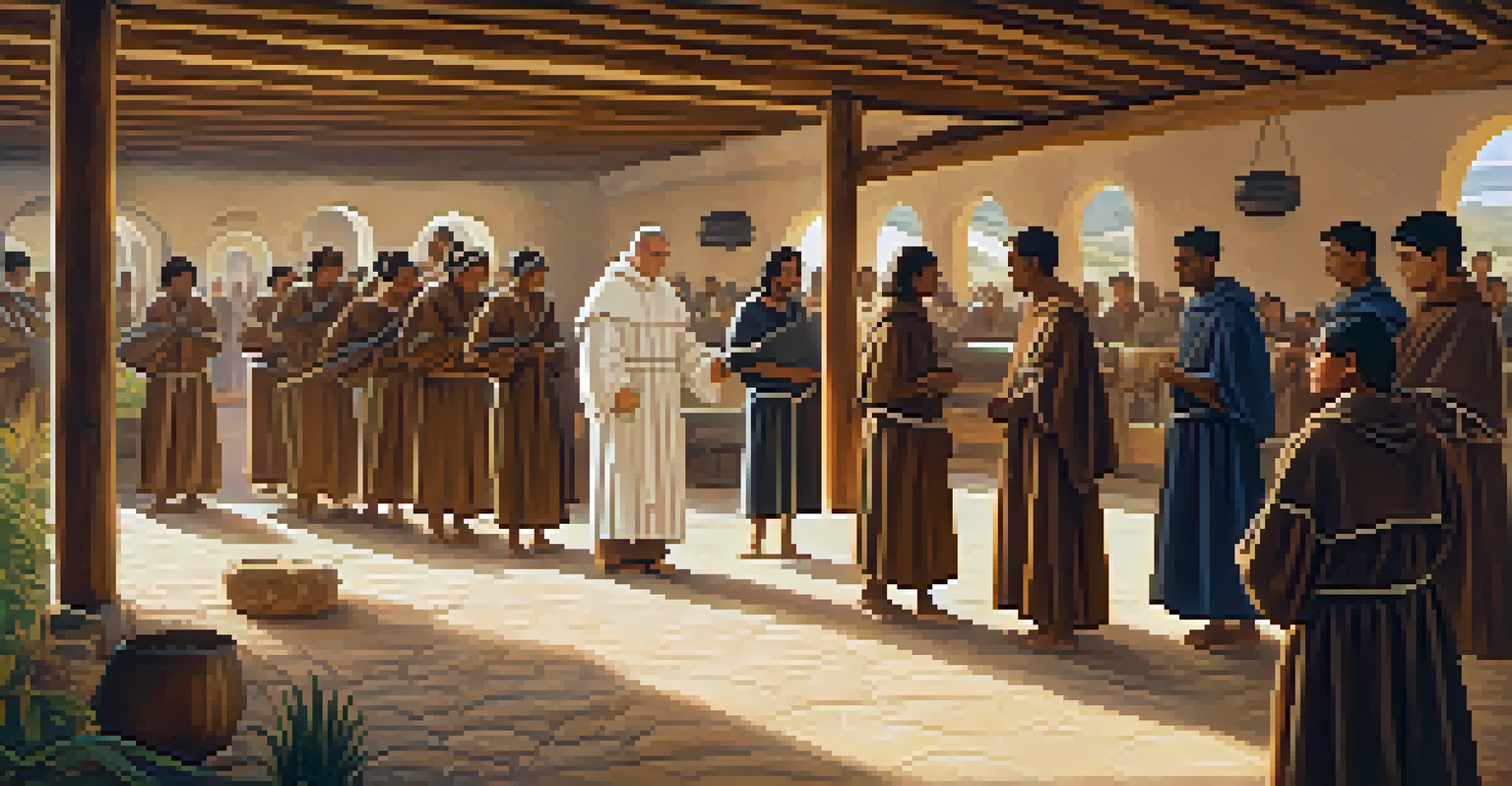The Legacy of Junipero Serra in California's Mission History

The Life of Junipero Serra: A Brief Overview
Junipero Serra was born in 1713 in Mallorca, Spain, and became a Franciscan friar. His journey took him to Mexico, where he dedicated himself to missionary work. In 1769, he arrived in California, where he would go on to establish a series of missions that would shape the region's history.
History is written by the victors.
Serra's dedication to his faith and mission was unwavering. He traveled along the California coast, often facing challenging conditions, to spread Christianity among the Indigenous populations. His commitment was not just to build churches but to create communities where faith and agriculture could thrive.
Despite his sincere intentions, Serra's legacy is complex. While he aimed to convert and educate, his methods often led to significant cultural disruption for Native peoples, leading to debates about his impact and historical significance.
The Establishment of California Missions
Serra founded nine missions between San Diego and San Francisco, each serving as a hub for religious and agricultural development. These missions were designed to be self-sufficient, with farming, livestock, and workshops to support the local communities. They became the backbone of California's early development.

Each mission had its unique structure and purpose, often reflecting the needs of the surrounding environment. For instance, Mission San Gabriel Arcángel was known for its fertile lands, while Mission San Juan Capistrano was famous for its exquisite architecture and gardens. These missions were not just religious outposts; they were centers of culture and community.
Serra's Missionary Legacy is Complex
Junipero Serra's efforts to spread Christianity in California resulted in both community development and significant cultural disruption for Indigenous peoples.
However, the impact of these missions extended beyond their walls. They played a critical role in the Spanish colonization of California, often leading to the displacement and suffering of Indigenous peoples. This duality of purpose continues to be a point of contention in evaluating Serra's legacy.
Serra's Role in Indigenous Education
One of Serra's aims was to educate Indigenous people in European ways of life, including agriculture, craftsmanship, and, of course, Christianity. He believed that by converting Native peoples, he could improve their lives, providing them with skills and knowledge that he thought would benefit them.
To know history is to know oneself.
At the missions, Indigenous individuals were taught to farm European crops and create goods for trade. While some embraced these opportunities, many others resisted, feeling that their traditional ways were being threatened. This tension highlights the complex nature of Serra's efforts and the varied responses from Indigenous communities.
Serra's approach to education was rooted in his faith, yet it often disregarded the existing cultures of Native peoples. This disregard has led to criticism from modern historians who argue that true education should respect and incorporate Indigenous knowledge and traditions.
Cultural and Religious Syncretism
The interaction between Serra's mission system and Indigenous cultures led to a unique blend of traditions, known as cultural syncretism. As Native peoples engaged with the missionaries, elements of both cultures began to merge, creating new practices and beliefs.
For example, some Indigenous people adopted aspects of Catholicism while retaining their traditional rituals. This blending illustrates the resilience of Indigenous cultures in the face of colonization and highlights the complexity of Serra's legacy in California's history.
Cultural Syncretism Emerged
The interaction between Serra's missions and Indigenous cultures led to a blending of traditions, illustrating both resilience and coercion in the face of colonization.
However, this syncretism was not always voluntary. Many Indigenous communities were coerced into adopting European customs, leading to the loss of their traditional identities. This aspect of Serra's legacy raises important questions about cultural preservation and the impact of colonization.
The Controversial Legacy of Junipero Serra
Junipero Serra's legacy is a subject of heated debate. On one hand, he is celebrated as a key figure in California's history, with numerous statues and honors in his name. On the other hand, many view him as a symbol of colonial oppression, criticizing the impact of his missions on Indigenous communities.
In recent years, discussions around Serra's legacy have intensified, especially as awareness of historical injustices has grown. Some communities have called for the removal of his statues and the reconsideration of how he is portrayed in history. This reflects a broader movement to reevaluate historical figures through a more critical lens.
Ultimately, Serra's legacy serves as a reminder of the complexities of history. It challenges us to consider multiple perspectives and recognize the profound impacts that individuals can have, both positive and negative, on the course of history.
Junipero Serra's Canonization and Its Implications
In 2015, Junipero Serra was canonized by Pope Francis, which sparked further debate about his legacy. For many, this recognition brought a sense of validation to Serra's missionary work and contributions to the Catholic Church. However, for others, it reignited discussions about the consequences of his actions on Indigenous peoples.
The canonization highlighted the ongoing tension between recognizing religious figures and acknowledging the historical context of their actions. While Serra is celebrated as a saint by some, others see the decision as overlooking the suffering of Native populations during his missions.
Debate Over Serra's Canonization
Junipero Serra's 2015 canonization by Pope Francis sparked renewed discussions about the implications of his actions on Indigenous communities and historical injustices.
This event underscores the importance of understanding history in its entirety, including the narratives of those who have been marginalized. It serves as a reminder that history is not just about names and dates, but about the lived experiences of people and the legacies that continue to shape our world.
Continuing Conversations About Serra's Impact
Today, discussions surrounding Junipero Serra and his legacy are more relevant than ever. Schools, museums, and communities are engaging in dialogues that explore the complexities of California's history, including the impacts of colonization and the experiences of Indigenous peoples.
These conversations are important as they help foster a deeper understanding of the past, encouraging people to reflect on how history influences present-day relationships and policies. By engaging in these discussions, we can work towards a more inclusive narrative that honors all perspectives.

Ultimately, the legacy of Junipero Serra is not just about one man; it’s about the broader implications of missionary work and colonization. It challenges us to consider how we remember history and how we can learn from it to create a more equitable future.